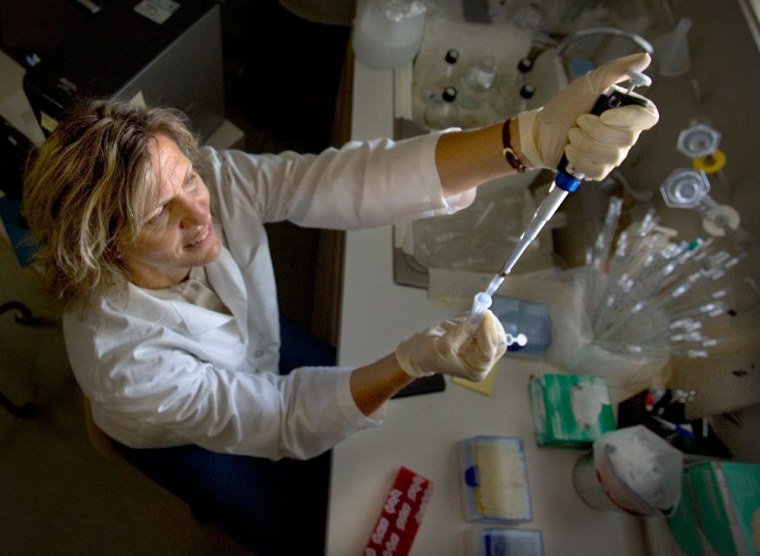Dr. Karen Rudolph didn't have much time.
Investigators had turned to the DNA expert after finding a knife with traces of blood in a suspect's truck. A few hairs were discovered at the crime scene hundreds of miles away, and authorities wanted to know if there was a link.
Two days later, working on delicate equipment in a state lab, Rudolph had an answer: The DNA on the knife was a match to the hair strands.
The suspect was arrested and charged — with poaching.
As the state's only wildlife DNA specialist, Rudolph handles evidence for many of Idaho's animal-related cases.
Rudolph's job requires her to identify an animal based on a hunk of tissue, wayward tuft of hair, bone chip or dried splatter of blood.
In many cases, her work has helped prosecutors win convictions and encouraged defendants to plead guilty without going to trial, officials said.
24/7 poaching
"Idaho poachers, until recently, were kind of your average Joe Bad Guy out in the woods doing small-fry things," said Rudolph.
"But now many of them literally hunt every day and night — looking for antlers to sell so some rich guy in Jackson Hole can have an antler chandelier, or ingredients to make some strange alternative medicine or to get a trophy for bragging rights. It's become commercial."
That means more high-stakes court cases, she said, with defendants hiring top-dollar attorneys and juries expecting high-tech evidence.
In one recent case, Gary Lehnherr and Ronnie Gardner both pleaded guilty in federal court to illegally killing a trophy mule deer in Lincoln County with a high-caliber center fire rifle.
Rudolph matched DNA in blood and hair found at the kill site — in an area where only muzzleloader hunting was allowed — with DNA from the deer's antlers, found in Lehnherr's home.
DNA also helped crack the case of a man who was suspected of trying to poison wolves in Wyoming and Idaho with pesticide-laced meatballs. No wolves were found dead, but the tainted meat was suspected in the death of more than 20 pet dogs.
First, DNA from some meatballs found at a crime scene was matched to DNA found in blood in a garage owned by a man named Tim Sundles. Sundles was headed for trial but pleaded guilty after more DNA evidence turned up.
Investigators had taken samples of yellow snow found at the crime scene that day, and suspected that the person who left the meatballs had relieved himself at the site. They were right, Breitsameter said — DNA from human cells found in the urine was a perfect match for Sundles.
The use of DNA evidence in wildlife investigations is fairly new, but it's being used more and more, Assistant U.S. Attorney George Breitsameter said.
"I'm not sure if that's because of people's expectations, but DNA is the modern fingerprint that people can use to attach an individual to a crime," he said.
At the tiny cinderblock Idaho Department of Fish and Game lab where Rudolph works in Caldwell, the mail may bring a cardboard tube filled with bear bait or a wrapped hunk of meat taken from someone's freezer.
Game wardens often stumble across crime scenes while they're hiking in the wilderness, Rudolph said, so they have to collect the evidence with whatever makeshift container they can find in their backpacks.
Sometimes Rudolph finds herself living something like a countrified scene from TV's "CSI."
"I've been given a bone saw that had tissue from different animals stuck between the tiny teeth of the blade. Once, I had to pick through a shop vacuum for tissue. We mostly found hair," she said.
Few states have their own wildlife DNA lab, said Ken Goddard, director of the National Fish and Wildlife Forensics Lab. So Goddard's lab in Ashland, Ore., handles wildlife evidence from across the nation, as well as for some international cases.
Some suspects, apparently unaware that investigators use advanced forensic techniques, get a little cocky and unwittingly help investigators, Rudolph said.
"One guy had a folding knife that a warden thought had been used in a poaching case, and when the officer asked for it, the guy laughed and said, 'Go ahead and take it. I've already cleaned it and boiled it and you won't find anything.'"
Back in the lab, Rudolph was undeterred. She put a layer of aluminum foil down on the lab counter and slowly opened the folding knife. As she ran a tiny brush over the hinge, the bristles dislodged a speck of dried blood.
The sample was minuscule. But it was enough to run a DNA test and connect the knife to the poached animal, she said. Another case closed.
